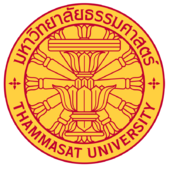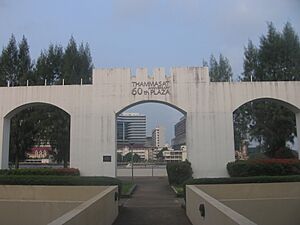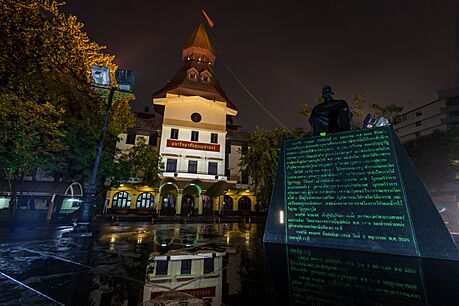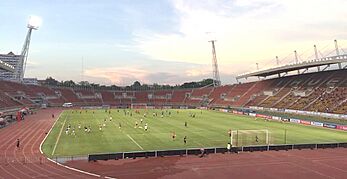Thammasat University facts for kids
|
มหาวิทยาลัยธรรมศาสตร์
|
|
 |
|
|
Former names
|
University of Moral and Political Sciences |
|---|---|
| Motto | For excellence, for justice, and readiness in leadership |
| Type | National |
| Established | 27 June 1934 |
| Founder | Pridi Banomyong |
| Budget | 17,444,989,498.60 Baht (2023) |
| Rector | Supasawad Chardchawarn |
|
Academic staff
|
2,082 |
| Students | 39,952 (2nd term, AY2023) |
| Undergraduates | 34,701 |
| Postgraduates | 5,251 |
| Location |
Phra Nakhon, Bangkok
,
13°45′27″N 100°29′24″E / 13.75750°N 100.49000°E |
| Campus | |
| Anthem | "Yung Thong" ('Golden Flamboyant') |
| Colors | |
| Affiliations |
|
| Mascot | Flamboyant Tree |
 |
|
Thammasat University (TU) is a big public university in Thailand. It has campuses in Bangkok, Rangsit, Pattaya, and Lampang Province. As of 2024, Thammasat University has over 39,000 students. They study in 33 different schools and colleges. There are also 2,000 teachers and staff.
Thammasat is Thailand's second oldest university. It officially opened on June 27, 1934. Its founder, Pridi Banomyong, named it the University of Moral and Political Sciences. It started as an "open university," meaning many people could join. In its first year, 7,094 students studied law and politics.
In 1960, the university changed its rules. It became the first in Thailand to require students to pass national entrance exams. Today, Thammasat offers more than 240 study programs. These are spread across 33 different faculties and colleges on its four campuses. Over 80 years, Thammasat has grown a lot. It started with law and politics, and now it's an international university. It offers many different degrees in many subjects. More than 300,000 students have graduated from Thammasat. Many of its graduates have become important leaders in Thailand. This includes prime ministers, politicians, and judges.
The Tha Phra Chan Campus is the original campus. It is in Phra Nakhon, Bangkok. This campus is near many famous places. It was also a key location for student protests in 1973 and 1976. The Rangsit campus is where most undergraduate students study. It is in Khlong Luang District, Pathum Thani. Thammasat also has smaller campuses in Lampang and Pattaya.
Contents
- Discovering Thammasat University's Past
- University Symbol
- Thammasat University Campuses
- Schools and Departments
- Faculty of Law
- Thammasat Business School
- Faculty of Political Science
- Faculty of Economics
- Faculty of Social Administration
- Faculty of Liberal Arts
- Faculty of Journalism and Mass Communication
- Faculty of Sociology and Anthropology
- Faculty of Science and Technology
- Faculty of Engineering
- Faculty of Medicine
- Faculty of Allied Health Sciences
- Faculty of Architecture and Planning
- Faculty of Pharmaceutical Sciences
- Faculty of Learning Sciences and Education
- Language Institute
- Sirindhorn International Institute of Technology
- College of Innovation
- School of Global Studies
- Chulabhorn International College of Medicine
- International Programs
- University Rankings
- Famous People from Thammasat
- See also
Discovering Thammasat University's Past
The name "Thammasat" comes from an old Buddhist term. It means "study of law."
Early Days: University of Law and Political Sciences

Thammasat University started in 1934. It was called the University of Law and Political Sciences. This was two years after a big change in Thailand's government in 1932. Pridi Banomyong, who helped create Thailand's democracy, thought of the idea. He was the Minister of Interior. He wrote the law to create the university in 1934. Pridi became the university's first leader.
The university followed a key idea from the "People's Party." This idea was that the government should give everyone a good education. Before, education was mostly for royal families. Students from an older law school wanted their school to become a university. This helped Thammasat become the new home for law studies. The old law school building was Thammasat's first location. The university moved to the Tha Phra Chan campus the next year.
When the university opened, 7,094 people wanted to join. At that time, another big university, Chulalongkorn, only graduated 68 students a year. Thammasat first offered degrees in law, economics, and political science. It also had a diploma in accounting. Soon, master's and doctoral degrees were added in these subjects.
In its early years, the university did not rely on government money. It used low tuition fees and money from a bank it partly owned.
During World War II, the university became a secret base. It was used by the Free Thai Movement. This group worked against the Japanese who were in Thailand. The campus also held Allied civilians. Thai guards protected them from the Japanese.
University Changes and Growth
A big change happened in Thailand in 1947. Pridi Banomyong had to leave the country. The original Thammasat degree programs were changed in 1949. New departments were created for Law, Political Science, Business, and Economics. The university had to sell its bank shares. This made it rely on government funding. The words "and Political Sciences" were removed from its name. Thammasat was no longer an "open university" for everyone. A new law for Thammasat University was passed in 1952. In the 1950s and 1960s, Thammasat added more faculties. These included social administration, journalism, liberal arts, and sociology.
Student Movements for Change
In 1973, Thammasat became a center for student protests. These protests led to a big uprising on October 14. Many students gathered at Thammasat University. They were protesting the arrest of thirteen student activists. The protests lasted several days. Then, a conflict happened near the Democracy Monument. When Thailand's military leaders left the country, Sanya Dharmasakti, who was Thammasat's rector, became Prime Minister.
Three years later, on October 6, 1976, another event happened at the Tha Phra Chan campus. This started with protests against a former leader returning to Thailand. Students staged a play on campus to show what happened to some protesters. Some newspapers printed pictures that caused anger. Police and other groups then surrounded Thammasat University. On October 6, they attacked the protesters. Many students were hurt or killed. Some students escaped by jumping into the Chao Phraya River.
One of the student leaders was Seksan Prasertkul. He wrote a protest song. He later became a teacher at Thammasat University.
Expanding Campuses and Programs
In the 1980s, Thammasat University built a new campus in Rangsit. This campus was for the new Faculty of Science and Technology. It welcomed its first students in 1985. The Faculty of Engineering opened at Rangsit in 1989. The Faculty of Medicine followed in 1990. By the late 1990s, all first-year students studied at Rangsit. Today, almost all undergraduate classes are taught at Rangsit. Some international English programs and special programs are still at Tha Phra Chan. Graduate degree classes are also still taught at Tha Phra Chan.
The Rangsit campus was also used for the 1998 Asian Games.
Thammasat University is part of international networks. These networks help students and researchers connect with universities in Europe and Asia.
University Symbol
The university's symbol shows the center part of the Democracy Monument, Bangkok. This monument honors Thailand's Constitution from 1932. The symbol is placed on a "wheel of law." This wheel represents the university's name in an old language called Sanskrit.
Thammasat University Campuses
Thammasat University has two main campuses in the Bangkok Metropolitan Area: Tha Phra Chan and Rangsit. It also has two regional campuses: Lampang and Pattaya.
Tha Phra Chan Campus
The Tha Phra Chan Centre is in Phra Nakhon District, Bangkok. It is surrounded by many famous cultural and historical places. These include Sanam Luang, the Grand Palace, and the Chao Phraya River. This was Thammasat's first permanent campus. It was bought in 1935 with money from public donations. The land was once part of a royal palace.
The most famous building on campus is the Dome. It was built from four old military buildings. The Dome was where Pridi Banomyong had his office. It was also a secret command center for the Free Thai Movement during World War II. Weapons were hidden in its attic for a planned uprising.
The Tha Phra Chan campus was important during student protests in 1973 and 1976.
Eight faculties are based at Tha Phra Chan. These include law, political science, economics, and liberal arts. As of 2019, mostly graduate programs and international English programs are offered here. The campus has a football field, a track, a gym, libraries, and cafeterias.
Rangsit Campus
The Rangsit Centre is the second and largest Thammasat campus. It is in Khlong Luang District, Pathum Thani Province. This is about 42 km north of Bangkok. Shuttle buses connect it to Tha Phra Chan. Thammasat University started engineering, technology, science, and medicine programs at Rangsit in the 1980s and 1990s. Since 2006, almost all bachelor's degree classes are taught here.
The campus has three main areas: academic, housing, and sports. The Thammasat University Sport Centre at Rangsit was used for the 1998 Asian Games and other big sports events.
In December 2019, the Rangsit campus opened Asia's largest urban rooftop garden. This 7,000 square meter space helps with climate change issues like flooding. It is open for anyone to grow rice, vegetables, or herbs.
Regional Campuses
Pattaya Centre is in Pattaya, Chonburi Province. This land was given to the university in 1987. Construction started in 1997. The Pattaya Centre offers advanced courses in rural development and management.
Lampang Centre is in Hang Chat District, Lampang Province. The university approved this center in 1996. It first held classes in the old city hall. In 2003, it moved to its current location. Thammasat Lampang has fewer than 1,000 students. They study special courses on local development, law, and design.
Schools and Departments
Thammasat University has 19 faculties (schools), seven colleges, and seven institutes.
| Main Schools and Departments at Thammasat University | |
|---|---|
| No. | Faculty/College/Institute |
| 1 | Faculty of Law |
| 2 | Thammasat Business School |
| 3 | Faculty of Political Science |
| 4 | Faculty of Economics |
| 5 | Faculty of Social Administration |
| 6 | Faculty of Liberal Arts |
| 7 | Faculty of Journalism and Mass Communication |
| 8 | Faculty of Sociology and Anthropology |
| 9 | Faculty of Science and Technology |
| 10 | Faculty of Engineering |
| 11 | Faculty of Medicine |
| 12 | Faculty of Allied Health Sciences |
| 13 | Faculty of Dentistry |
| 14 | Faculty of Nursing |
| 15 | Faculty of Fine and Applied Arts |
| 16 | Faculty of Architecture and Planning |
| 17 | Faculty of Public Health |
| 18 | Faculty of Pharmacy |
| 19 | Faculty of Learning Sciences and Education |
| 21 | Language Institute |
| 22 | Sirindhorn International Institute of Technology |
| 23 | College of Innovation |
| 24 | College of Interdisciplinary Studies |
| 27 | Pridi Banomyong International College |
| 28 | School of Global Studies |
| 29 | Chulabhorn International College of Medicine |
| 30 | Puey Ungphakorn School of Development Studies |
Faculty of Law
The Faculty of Law was one of the first schools at the university. It started from a law school of the Ministry of Justice. It offers degrees up to the doctorate level.
Thammasat Business School
The Thammasat Business School (Faculty of Commerce and Accountancy) opened in 1938. It is one of the oldest business schools in Thailand. It offers many programs like business administration, accounting, finance, and marketing. It also has international programs taught in English.
This school is recognized around the world. It has received special certifications from three global groups (EQUIS, AACSB, and AMBA). Less than 1% of business schools worldwide have all three.
Faculty of Political Science
The Faculty of Political Science started in 1949. It offers studies in politics, public administration, and international affairs. Many Thai leaders and government officials have graduated from this school. It also has international programs taught in English.
Faculty of Economics
The Faculty of Economics at Thammasat University opened in 1949. It is the oldest economics school in Thailand. Under the leadership of Dr. Puey Ungpakorn, it grew a lot. Dr. Puey brought teachers from US universities.
In 1969, it started a Master of Economics program taught in English. Later, bachelor's and PhD programs in English were added. The school has many teachers with doctoral degrees. Its graduates often get accepted into top economics programs around the world.
Faculty of Social Administration
This faculty helps with state policies, welfare, and social security. It teaches about social welfare, justice, and social development. It was the first school in Thailand to teach social science for welfare studies.
Faculty of Liberal Arts
The Faculty of Liberal Arts was created in 1961. It first taught general subjects to all university students. Now, it offers many undergraduate, master's, and doctoral degrees. These include Psychology, History, English, French, Japanese, Chinese, and Philosophy. It also has international programs taught in English.
The English Department is well-known in Thailand. It offers programs in translation, linguistics, and literature. It also has higher-level programs for English language teaching.
Faculty of Journalism and Mass Communication
The Department of Journalism started in 1954. It was Thailand's first higher education institute for journalism. It became a full faculty in 1979. Today, it offers programs in newspaper, radio, TV, film, advertising, and public relations. It also has master's and doctoral degrees.
There is an international program for journalism and mass media studies (BJM). The faculty provides tools and studios for students to practice. They also have student-run magazines and newspapers.
Faculty of Sociology and Anthropology
This faculty started as a department in the Faculty of Social Administration. It became a separate faculty in 1976. It aims to train sociologists and anthropologists who can help society through research.
Faculty of Science and Technology
The Faculty of Science and Technology was founded in 1986. It was the first full faculty at the Rangsit Campus. It started with mathematics, statistics, computer science, and environmental science. It now teaches many science subjects. These include pure sciences and sustainable technologies. It also has international programs.
Faculty of Engineering
The Faculty of Engineering was founded in 1989. It started teaching electrical and industrial engineering in 1990. It later added civil, chemical, and mechanical engineering.
The faculty has an international department taught in English. It offers a "sandwich program" where students study two years at Thammasat and two years at a foreign university. Many graduates continue their studies at top universities in the UK.
Faculty of Medicine
The Faculty of Medicine started in 1990. It was the ninth public medical school in Thailand. It offers undergraduate and graduate courses in medicine. It also has master's and doctoral programs. It is the first medical school in Thailand to use a "Hybrid Problem-based learning" method. This focuses on case studies and community problems instead of just lectures.
Faculty of Allied Health Sciences
This faculty was established in 1994. It offers many undergraduate and graduate courses. Undergraduate studies include Medical Technology, Physical Therapy, and Sports Science. All programs are at the Rangsit Campus.
Faculty of Architecture and Planning
This faculty started as an Architecture Program in 1999. It became a full faculty in 2001. It offers programs in Architecture, Interior Architecture, and Urban Environmental Planning. It also has programs in Landscape Architecture and Real Estate Development.
Faculty of Pharmaceutical Sciences
This faculty focuses on research in Pharmaceutical Sciences. It aims to improve community health. It offers programs in Pharmaceutical Sciences and Pharmaceutical Care.
Faculty of Learning Sciences and Education
This faculty was founded in 2014. It is at the Rangsit Campus. It studies education and learning from different angles. It offers master's and bachelor's degrees. The faculty also has its own school, Thammasat Secondary School. This school promotes active learning and problem-based learning.
Language Institute
The Language Institute of Thammasat University (LITU) started in 1985. It helps Thammasat students learn English. LITU teaches English courses at all three campuses. It also offers language services to the public.
LITU teaches English to new students and throughout their studies. It also has international graduate degree programs for English language teaching.
Sirindhorn International Institute of Technology
The Sirindhorn International Institute of Technology (SIIT) is at the Rangsit Centre. It was established in 1992. It offers science, technology, and engineering education. All its programs are international and taught in English. SIIT is self-managed and funded. It has strong connections with research agencies and international universities.
SIIT is known for its research. It has a high number of research publications compared to other university units. It also gets many prestigious research grants for PhD students.
College of Innovation
This college was established in 1995. It focuses on interdisciplinary education. This means it combines different subjects. It offers degrees in areas like technology management, cultural management, and service innovation.
School of Global Studies
The School of Global Studies is a new academic initiative. It offers degrees in Global Studies and Social Entrepreneurship. It also has a master's degree in Innovation and Sustainability.
Chulabhorn International College of Medicine
This is the twenty-first medical school in Thailand. It is in Khlong Luang District, Pathum Thani. It is the first school in Thailand to offer an international medical course. It opened in 2012. It works with Thammasat University Hospital for student training.
International Programs
Thammasat University offers many international programs. These are for undergraduate, master's, and doctoral degrees. They cover social sciences, humanities, science, technology, urban design, and health sciences.
University Rankings
| University Ranking | |
|---|---|
| Domestic rankings (international rankings) | |
| Assessment by | Rank |
| QS (Asia) (2025) | 4 (128) |
| QS (world) (2019) | 3 (601-650) |
| QS (graduate employability ranking) (2019) | 2 (201-250) |
- Thammasat University has received "Four QS Stars." This means it is very international and excellent in research and teaching.
- It is ranked 2nd for being highly competitive in Thailand's university admission system.
- In 2019, QS World Ranking placed Thammasat 601-650th globally. It was 3rd in Thailand.
- In 2025, QS Asia ranked Thammasat 128th in Asia.
- In 2019, QS Graduate Employability Rankings placed Thammasat 2nd in Thailand and 200–250th globally.
QS World University ranking by subject 2019
| World rank | Domestic rank | Main subject |
|---|---|---|
| 151 - 200 | 1 | Law and Legal Studies |
| 151 - 200 | 2 | Geography |
| 151 - 200 | 2 | Politics |
| 201 - 250 | 2 | Linguistics |
| 251 - 300 | 2 | Business & Management Studies |
| 251 - 300 | 2 | Accounting and Finance |
| 343 | 2 | Social Science & Management |
| 401 - 450 | 2 | Economics and Ecometrics |
| 451 - 500 | 3 | Arts and Humanities |
| 451 - 500 | 4 | Medicine |
| 551 - 600 | 3 | Computer Science and Information System |
Famous People from Thammasat
Many important people have been part of Thammasat University.
Well-Known Teachers
- Princess Galyani Vadhana, a princess of Thailand, was head of the foreign language department.
- Pridi Phanomyong, the university's founder and a former prime minister.
- Puey Ungpakorn, a former governor of the Bank of Thailand and former leader of the university.
- Sanya Dharmasakti, a former prime minister and former leader of the university.
- Abhisit Vejjajiva, a former prime minister and former teacher.
Famous Graduates
Many Thammasat graduates have become leaders in Thailand. This includes several prime ministers like Tanin Kraivixien, Chuan Leekpai, Samak Sundaravej, and Somchai Wongsawat.
Other notable alumni include:
- Sirikan Charoensiri, a human rights lawyer.
- Thanathorn Juangroongruangkit, a Thai politician.
- Surin Pitsuwan, a politician and former Secretary-General of ASEAN.
- Rewat Buddhinan, a pioneer in Thai pop music.
- Aniporn Chalermburanawong, an actress and Miss Universe Thailand 2015.
- Ranee Campen, a famous actress.
- Vachirawit Chivaaree, a Thai actor and singer.
- Metawin Opas-iamkajorn, a Thai actor.
See also
 In Spanish: Universidad Thammasat para niños
In Spanish: Universidad Thammasat para niños










